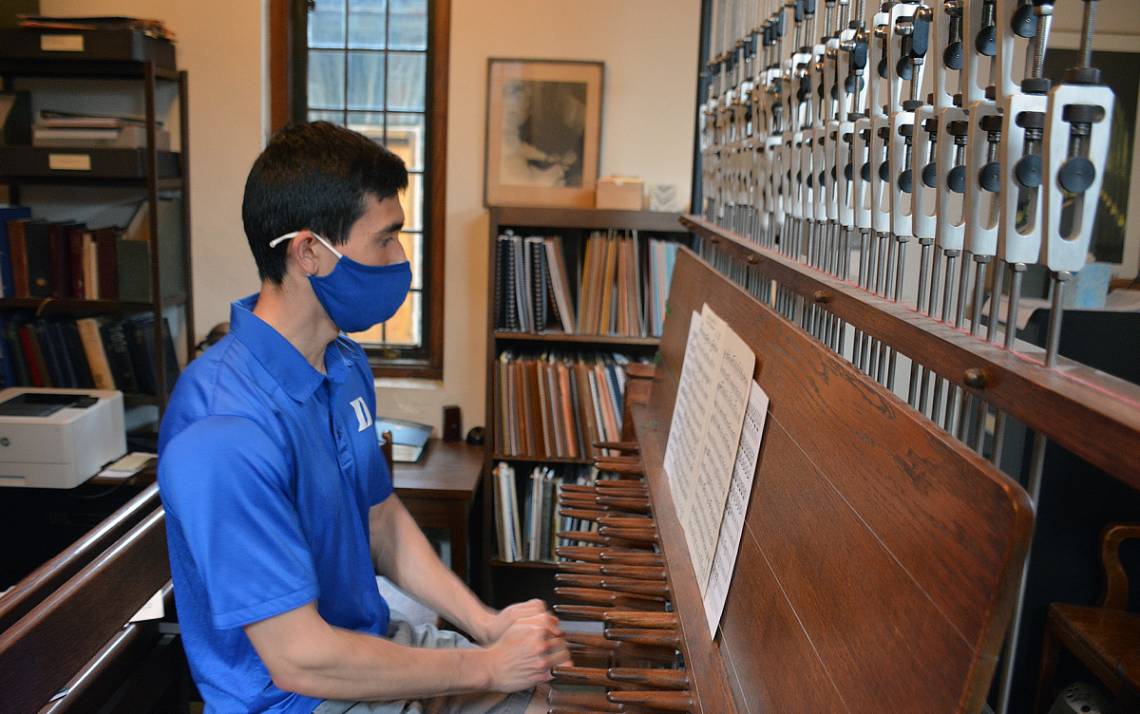Amidst a Pandemic, the Chapel Bells Keep Ringing
Carillonneur Joseph Fala continued daily recitals during the pandemic

With a clenched fist and a bead of sweat trickling down his forehead, Joseph Fala swings his hand over a collection of 50 oak keys high above Duke University.
 As Fala presses the keys of the 50-bell carillon, a familiar sound of campus life spills across campus as Duke University Chapel’s bells ring to the hymn “I Vow to Thee, My Country.” The bells, which range from 10 pounds and 4 inches in diameter to 11,200 pounds and the size of a queen bed, take a mighty effort to play.
As Fala presses the keys of the 50-bell carillon, a familiar sound of campus life spills across campus as Duke University Chapel’s bells ring to the hymn “I Vow to Thee, My Country.” The bells, which range from 10 pounds and 4 inches in diameter to 11,200 pounds and the size of a queen bed, take a mighty effort to play.
“I play with my hands in a fist because you have to put some might into playing an instrument this size,” said Fala, one of Duke Chapel’s carillonneurs. “A tap of your finger isn’t going to get the job done. You need to use your body weight.”
With many staff and faculty working remotely since March of 2020, Fala has been part of team of Chapel carillonneurs, along with Tom Gurin and Paul Bumbalough, who played the carillon to a mostly empty West Campus. Each weekday, one of them climbed the 169 steps up the Duke Chapel tower to continue a campus tradition: Since 1932, a carillonneur has rung the chapel’s largest bell at 5 p.m. every weekday followed by a 15-minute recital.
 “What our carillonneurs do with their musical talent is a gesture at the mood of the day by playing pieces that are in turns sorrowful, playful and hopeful,” said the Rev. Luke Powery, dean of Duke Chapel. “This past year, it has been so important to continue this public rite that reflects our collective sadness, longings and even trust in God.”
“What our carillonneurs do with their musical talent is a gesture at the mood of the day by playing pieces that are in turns sorrowful, playful and hopeful,” said the Rev. Luke Powery, dean of Duke Chapel. “This past year, it has been so important to continue this public rite that reflects our collective sadness, longings and even trust in God.”
The Duke Chapel carillon, which was installed in 1932, has 50 keys and 26 pedals that connect to metal wires that activate clappers mounted a few inches from the lip of each bell. The carillon was renovated in 1992 by John Taylor & Co. Bell Foundry of Loughborough, England, the same company that built the instrument. And in 2018, Duke named the carillon in honor of J. Samuel Hammond, the university carillonneur for 53 years who passed away in February 2021.
Hammond mentored Fala, who became a chapel carillonneur in 2019.
“Sam taught me that there’s less of a prescribed technique when it comes to the carillon,” Fala said. “He encouraged me to discover my own style of playing and listen to my musical intuition.”
About 4:15 p.m. on weekdays, Fala climbs about two-thirds up the Duke Chapel tower to a small enclosed cabin beneath the bells. Within the room are two identical keyboards. One is a practice carillon – connected to metal bars rather than bells – that Fala uses to rehearse the day’s pieces.
 Fala usually decides what to play on the morning of each performance. He selects hymns from Duke Chapel’s previous Sunday service, pieces from pop culture such as “Beauty and the Beast” or music timed to a holiday, like the French national anthem for Bastille Day. In a tradition started during Terry Sanford’s tenure as university president, Fala plays the Duke Alma Mater, “Dear Old Duke,” every Friday.
Fala usually decides what to play on the morning of each performance. He selects hymns from Duke Chapel’s previous Sunday service, pieces from pop culture such as “Beauty and the Beast” or music timed to a holiday, like the French national anthem for Bastille Day. In a tradition started during Terry Sanford’s tenure as university president, Fala plays the Duke Alma Mater, “Dear Old Duke,” every Friday.
Since the pandemic outbreak, the carillon recitals have been livestreamed on Duke Chapel’s Facebook page for everyone to hear. Fala brings an iPad to a balcony overlooking Abele Quad so listeners can enjoy a view of campus during a concert.
Each livestream has received hundreds of views and has comments from Duke alumni, employees and community members listening from Asheville, New Jersey, Florida and beyond.
 “It’s been a lot of fun to bring music to people who can’t be on campus,” Fala said. “It’s nice to know that my music might bring some joy into someone’s day, especially during the height of the pandemic when peace was so hard to come by.”
“It’s been a lot of fun to bring music to people who can’t be on campus,” Fala said. “It’s nice to know that my music might bring some joy into someone’s day, especially during the height of the pandemic when peace was so hard to come by.”
At the end of each carillon performance, Fala pulls a small leather journal from a bookshelf in the cabin under the bells. He writes down the date and each song performed so carillonneurs don’t repeat performances frequently.
“The carillon is wrapped into the fabric of Duke tradition,” Fala said. “It’s an honor to carry on that legacy. The bells provide a sense of hope to those listening on campus or online.”
Got a story idea? Send ideas, shout-outs and photographs through our story idea form or write working@duke.edu.